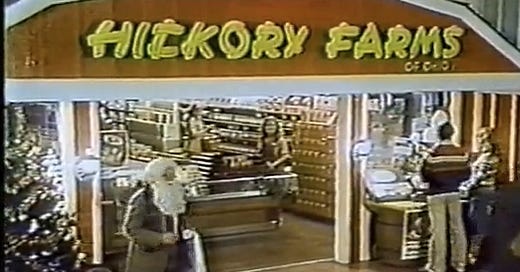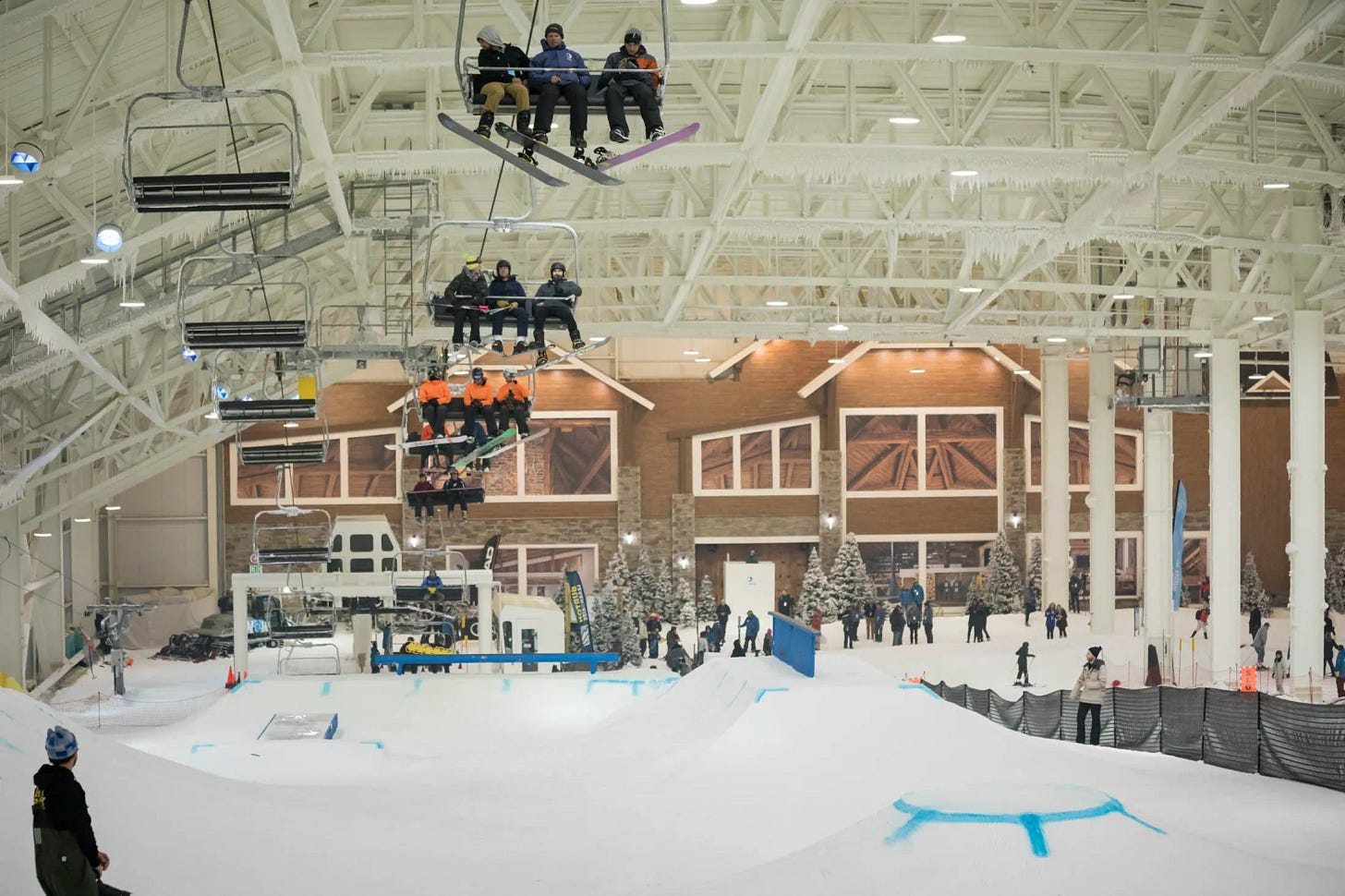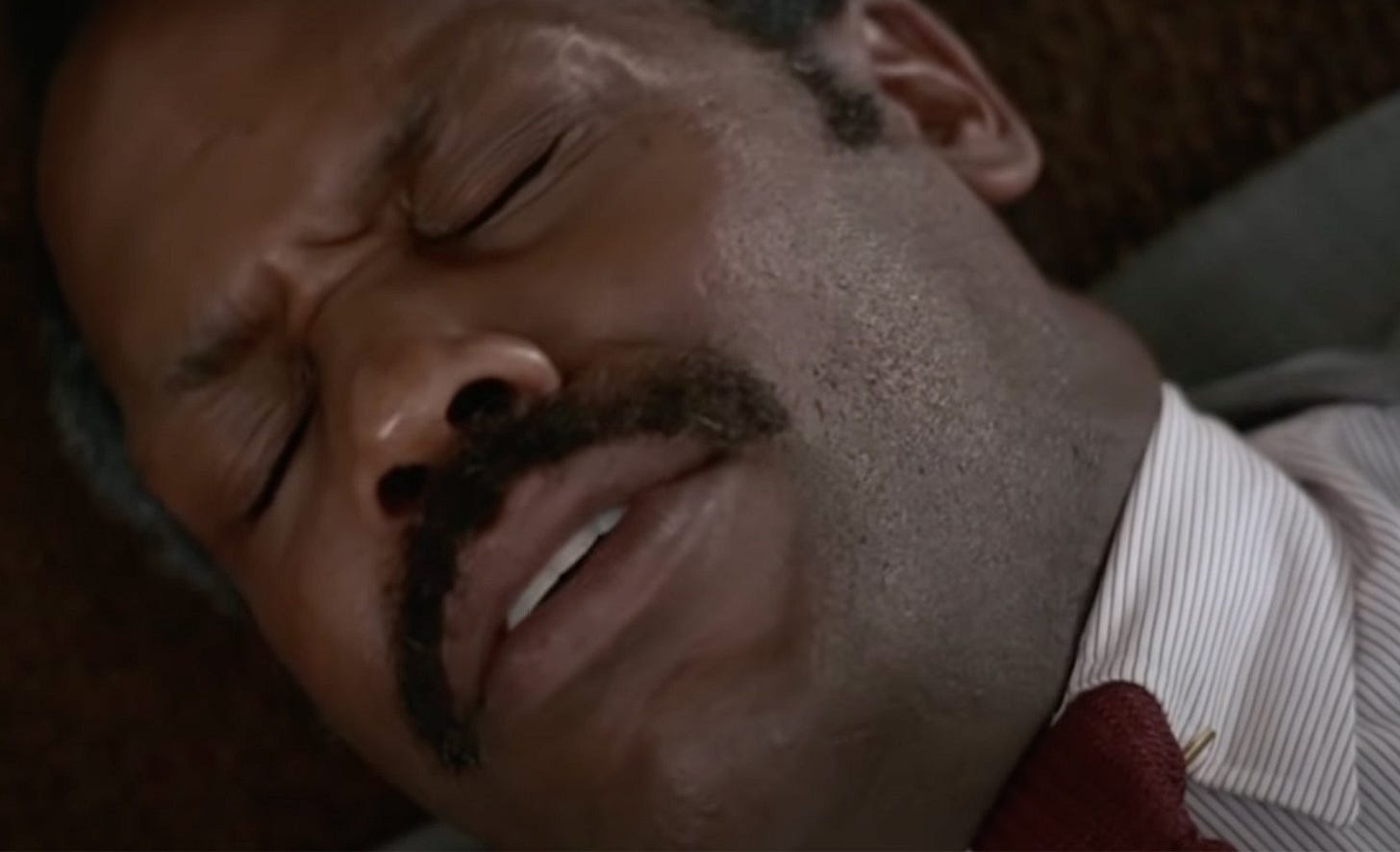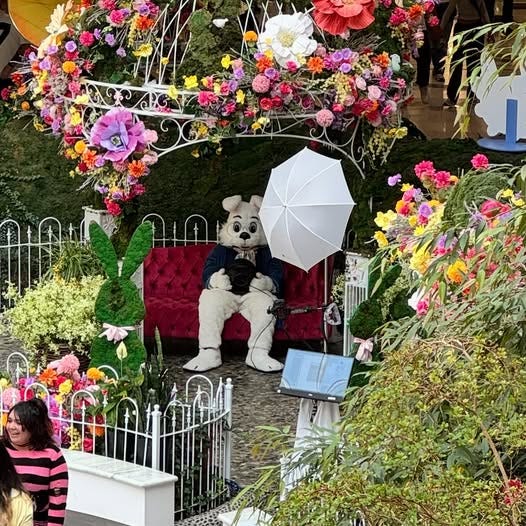I grew up in New Jersey in the 80s. The mall was my second home. Like Bane and darkness, I was born in it, molded by it.
When I was young, we went to the Shore Mall almost every week. It’s gone now, but for more than a decade, from the early 70s to the mid 80s, it was what passed for a “fancy” shopping center in the Atlantic City area. We rarely had much money, but my mother liked going there anyway, browsing in the stores, spending what little cash she had on tchotchkes for our house and makeup and other sundry things for herself. I amassed a collection of iron-on t-shirts from a kiosk that sold shirts reading HOME OF THE WHOPPER with an arrow pointing towards the wearer’s crotch, which was the height of humor for 10 year-old me.
We had a routine. While my mother browsed the clothing stores (which I found terribly boring), I’d go to Space Port, a cramped and curiously low-lit arcade with a back door leading directly out to the parking lot. Dig on that for a minute: a video arcade, where children congregated1, was badly lit and had an exit that made it easy to slip out unnoticed. You’d think kids would have been disappearing left and right from there like it was the Derry of New Jersey, and yet no one did.
ANYWAY, after a half hour or so of my immediately dying while playing Dragon’s Lair, I’d meet my mother for lunch at the same spot: Orange Julius. I was going to say that if you remember Orange Julius it’s time to schedule your colonoscopy, but apparently you can still get their signature drink, a strange concoction of orange juice and milk, at some Dairy Queen stores. That, plus a shriveled hot dog, topped off the day, and going to the mall with Mom would be one of a very small number of positive memories I have about our relationship.
By the time the Hamilton Mall opened in Mays Landing in 1988, my parents had divorced, I was living with my father, and trips to the mall with Mom, who I wasn’t getting along with too well at that point, were few and far between. The opening of the Hamilton Mall was such a big deal that it got a two-page spread in the local high school’s yearbook. Shore Mall was declining by then, and we were hungry for a new shining beacon of commerce. Hamilton Mall was bigger (two whole floors!), brighter, and had the upscale vibe that Shore Mall lacked even in its heyday. You couldn’t get a t-shirt that proclaimed you to be THE MAN, and your penis to be THE LEGEND, but you could buy designer clothes and cosmetics at Macy’s.
Best of all, you could get there by bus, and it ran right past my condominium development. Just about every Saturday from 1988 to 1991, I hopped on that bus and spent the entire day at Hamilton Mall. I had a routine then too, spending much of my time in three stores: Suncoast Pictures (R.I.P.), Sam Goody (R.I.P.), and Waldenbooks (R.I.P.). Suncoast was mostly aspirational, the place I planned to shop at “when I’m rich” (which has not happened yet); the majority of my money was spent amassing cassingles from Sam Goody, or buying books and/or magazines at Waldenbooks, which I would read in the food court while eating either Taco Bell or Arby’s (I am not a proud woman). I can’t remember what I had for lunch yesterday, but I remember sitting in Hamilton Mall’s food court sipping on a soda while reading IT when it came out in paperback, as well as The Secret Diary of Laura Palmer, which I read cover to cover in one scandalized afternoon.
Shore Mall is completely gone, like gone-gone, an empty lot now. Hamilton Mall is a depressing shell, housing mostly stores that appear to be selling items that fell off the back of a truck somewhere. Towson Town Center in Maryland, the (extremely fancy) mall I lived near when my daughter was born, is still both in operation and surprisingly still fancy as best as I can tell, but it’s a rarity. As many people more erudite than I have already noted, the era of the shopping mall has passed. Though whether or not malls are completely dead is a matter of debate, there are certainly far fewer of them, only around 700 in the U.S. as of 2023, down from a peak of approximately 2,500 in the early 90s.
It doesn’t take an economics degree to understand why this happened: already taking a hit from the rise of e-commerce, the 2009 recession was the death blow, and COVID-19 was merely kicking the corpse. Oversaturation was also a significant issue: when you have six megamalls within a 20-mile radius of each other, and none of them have anything to distinguish one from another, a few will suffer. The good news is that some abandoned malls are being converted into housing (though not as many as there should be). The bad news is that suburban towns have lost community gathering areas, and places for teenagers to hang out Even in the malls that are still standing, teens are now often banned from being in them after a certain hour, or without an adult chaperone, because we’ve come to equate “teens” with “the enemy.”
However, one mall, appropriately in New Jersey (once the mall capital of the world), seems to be rising from the grave. It is American Dream (not The American Dream Mall, just American Dream), a place that, if you were to fictionalize it, you’d be accused of lacking subtlety.
To call American Dream a mere mall is to understate it. It’s a sprawling behemoth across from the former Meadowlands Stadium (and thus Jimmy Hoffa’s corpse) that has its own exit off the highway, like you’re in Anaheim on the way to Disneyland. You can see it from several miles away, because there’s a giant Ferris wheel sticking out of the top of it, and what appears to be an unfinished parking garage jutting out of one end, but it’s actually an indoor ski slope.
American Dream is a spectacle more than 20 years in the making. Originally called Xanadu, if you want a long and exhaustively detailed explanation of the struggle to get it both funded and built, you can read the Wikipedia page for it. Modeled after Minnesota’s Mall of America (and only slightly smaller), American Dream is both a shopping complex and an amusement destination, housing a theme park and a full-scale waterpark and an aquarium and an ice skating rink and a giant Ferris wheel and an indoor ski slope2, which, even when you see it in action, still seems like it might be a creation of the Matrix.
Considering how many times it changed hands in ownership and management before it even opened, American Dream seemed like a boondoggle waiting to happen. This only seemed moreso when the complex began opening just five months before COVID-19 shut everything down. The Nickelodeon Universe theme park was scheduled to open literally a week before.
Again, if you wrote this into a movie, it’d get sent back for rewrites.
Yet it somehow defied expectations, and American Dream remains open, a baffling, amusing, and almost poignant tribute to excess that’s evidently hoping to appeal to one-stop shoppers who might drop $5,000 for a purse at Balenciaga and then tuck into a Wendy’s Baconator afterward. I’m not sure those shoppers actually exist, but fine.
My companions and I took a bus that operates strictly to take people from New York City to American Dream and back again. Over the main entrance of the complex is a sign reading as thus:
AMERICAN DREAM
SHOP 7 DAYS A WEEK
I’m not implying that the sign is suggesting something so crass as the American Dream is to be able to shop seven days a week, but also this place has five rollercoasters and a ski slope inside it.
Anyway, we were barely inside before we were threatened by the dead-eyed grin of Jimmy “Mr. Beast” Donaldson, inviting us to check out his burger restaurant, so far the only brick and mortar version of it in the world (it’s reportedly terrible). Just as Robert Frost once wrote (because he definitely meant a mall in New Jersey), near the Mr. Beast burger sign, the road diverged. The road on the left went towards “The Avenue,” where all the high-end stores like Gucci and Tiffany’s were located. The one on the right went towards where the riff-raff shop, and eventually where all the amusements were.
Nothing can prepare you for the sheer volume of this section of American Dream. We were several football fields away from any of the amusement parks, and it still sounded like we were trapped inside a bus carrying a high school marching band and 12 Swedish nightclub DJs barrel-rolling down an endless hill. At one point, we were in what would be the opposite of a sweet spot, where directly below us a Rock Paper Scissors tournament was happening, and nearly every store in the immediate vicinity was blasting their own unique oontz oontz oontz music at a level unheard of since the United States military drove Manuel Noriega out of hiding.
It’s a far cry from the malls of yore, when the only music you heard beyond record stores was a soft instrumental version of “For Your Eyes Only” playing barely noticeable in the background. But again, to call American Dream a “mall” is underselling it. It’s an experience. Someone on Reddit described it as “if America was the first to colonize Mars,” and I can’t think of a better description than that, right down to the “sponsored by Coca-Cola” signs prominently displayed in the central food court.
How well American Dream is doing depends on who you ask, and either it’s defying cynical expectations, or it’s on the brink of bankruptcy, and will eventually sink into the swampland it’s built on. Reportedly it struggles with high retail turnover rates (meaning smaller stores aren’t likely earning enough profit to cover what must be exorbitant rent), and the amusement parks operate with a skeleton crew for maintenance (meaning there’s never a point when all the rides are running at the same time), neither of which points to long-term success.
From my own (admittedly limited) observations, if you rated American Dream’s success on how many people were walking around in it when I was there, it’s doing great. However, it seemed like most of them were there for the same reason we were: to gawk and then never return, except maybe to bring someone else who wants to gawk at it. You’d expect an extravagantly large “shopping and entertainment complex” to have people walking around loaded down with bags, but everyone there seemed more interested in taking pictures in front of the numerous TikTok and Instagram-ready photo areas than buying anything.
No one was riding the Ferris wheel, either because it was a steep $30 a pop, or because the entrance was indifferently tucked away in a back corner of one of at least four food courts. The curious layout of American Dream might very well be its downfall: though we were warned of the presence of Mr. Beast Burger the very second we walked into the main entrance, even after walking around for over 3 hours we never actually encountered it. Every section was either too cramped or too empty, and the choices in retailers weird and random: there were at least two stores that sold nothing but sunglasses, something called The Beef Jerky Experience3, and more places to buy Funko POP dolls and anime doohickeys than you could ever need, but as best as I can tell only one (1) pharmacy, so bring your own aspirin if the noise level in there gets to be too much for you (and it will).
Perhaps most telling was the fact that “The Avenue,” where all the fancy “if you have to ask you can’t afford it” stores were located, seemed to be mostly where people went to get a break from the frenetic mood of the amusement area. Quiet as a hospital ICU ward (and sterile as a dentist’s office), almost none of the stores were occupied by anyone but bored-looking clerks, undoubtedly dreading having to waste half their lunch breaks making the arduous journey to the affordable food court (sponsored by Coca-Cola).
Plus, there was this lonely Easter Bunny, which best illustrated the vibe:
And yet, I didn’t hate the place. I enjoyed it in the same way that I enjoy watching 70s variety specials, in that the tackiness was part of its charm. Its extravagance in the face of a world teetering on the brink of destruction was almost inspiring, and all it was missing was someone dressed as SpongeBob SquarePants standing in the middle of it all shouting “Remain calm! All is well!” in an increasingly panicked voice, like Kevin Bacon in Animal House.
I shouldn’t have found it strange that people would be skiing indoors, in New Jersey, on a day when it was almost 80 degrees outside. That’s actually perfect, and in keeping with the bizarre Upside Down times that we’re living in. So too is the three-story tall Statue of Liberty sculpted out of jelly beans that stands in front of chain candy store It’s Sugar, and represents “the freedom to treat yourself.” I may be anti-capitalism, but I’m very pro-audaciousness, and if something as out of touch (and out of time) as American Dream can survive, then maybe things will be alright. Maybe we’ll be alright.
There was also the fact that my mother let me roam around the mall unattended, which today would probably earn her a call from child protection services. There were a lot of reasons she had no business having children, but that probably wasn’t one of them.
…and two separate mini-golf courses and a laser tag arena and an escape room and a climbing gym and the New Jersey Hall of Fame and something called “Bubble Planet” and Blast 7D, described as “an immersive 7D ride” (I didn’t even know they invented 5 and 6D already!)
Great band name, though.









As someone who works in a mall, the death of malls in general is overplayed. Some malls, yes. Some areas are overmalled, and some areas have outgrown the malls they have. But believe it or not, you can't buy everything online. And sometimes you need something now, and even Amazon free overnight shipping might not get there in time. A lot of expensive designer stores either don't sell online, or don't sell the entire line online.
Every time I go to Scottsdale, I am amazed at the number of bustling strip malls (really more upscale than 'strip', but not a 'regular' mall either), with busy parking lots and a constant flow of people. The key is the mix: coffee place, fast casual restaurants, nicer restaurants, a grocery store, several stores and maybe a licensed workout place/yoga/pilates.
And as a Minnesotan who goes to the Mall of America several times a year, I enjoy the experience of having all the stores under one roof, getting a ton of steps in, and just being around a group of people who want to be somewhere, even if I don't know them.
I can smell that picture of Hickory Farms